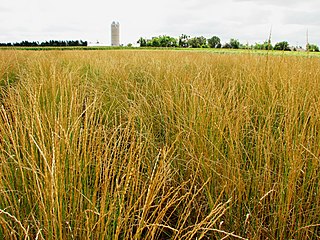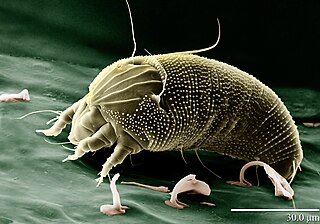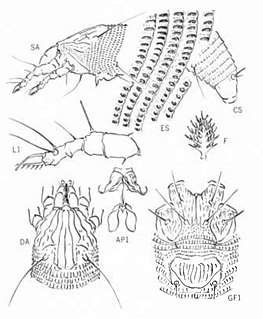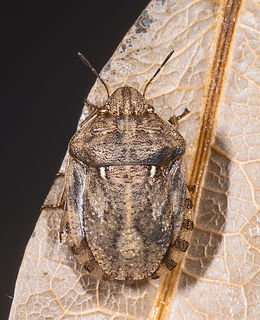
In botany, a bulb is structurally a short stem with fleshy leaves or leaf bases that function as food storage organs during dormancy.

Whiteflies are Hemipterans that typically feed on the undersides of plant leaves. They comprise the family Aleyrodidae, the only family in the superfamily Aleyrodoidea. More than 1550 species have been described.

The silverleaf whitefly is one of several species of whitefly that are currently important agricultural pests. A review in 2011 concluded that the silverleaf whitefly is actually a species complex containing at least 40 morphologically indistinguishable species.
Blissus leucopterus also known as the true chinch bug is a small North American insect in the order Hemiptera and family Blissidae. It is the most commonly encountered member of the genus Blissus, which are all known as chinch bugs. A closely related species is Blissus insularis, the southern chinch bug.

Eriophyidae is a family of more than 200 genera of mites, which live as plant parasites, commonly causing galls or other damage to the plant tissues and hence known as gall mites. About 3,600 species have been described, but this is probably less than 10% of the actual number existing in this poorly researched family. They are microscopic mites and are yellow to pinkish white to purplish in color. The mites are worm like, and have only two pairs of legs. Their primary method of population spread is by wind. They affect a wide range of plants, and several are major pest species causing substantial economic damage to crops. Some species, however, are used as biological agents to control weeds and invasive plant species.

Ditylenchus dipsaci is a plant pathogenic nematode that primarily infects onion and garlic. It is commonly known as the stem nematode, the stem and bulb eelworm, or onion bloat. Symptoms of infection include stunted growth, discoloration of bulbs, and swollen stems. D. dipsaci is a migratory endoparasite that has a five-stage lifecycle and the ability to enter into a dormancy stage. D. dipsaci enters through stomata or plant wounds and creates galls or malformations in plant growth. This allows for the entrance of secondary pathogens such as fungi and bacteria. Management of disease is maintained through seed sanitation, heat treatment, crop rotation, and fumigation of fields. D. dipsaci is economically detrimental because infected crops are unmarketable.

Wheat streak mosaic virus (WSMV) is a plant pathogenic virus of the family Potyviridae that infects plants in the family Poaceae, especially wheat ; it is globally distributed and vectored by the wheat curl mite, particularly in regions where wheat is widely grown. First described in Nebraska in 1922, stunted growth and the eponymous “streaks” of yellowed, non-uniform discoloration are characteristic of WSMV infection. As it has been known to cause 100% crop mortality, WSMV is a subject of ongoing scientific research.
Aceria malherbae is a species of gall mite known as the bindweed gall mite. It is used as an agent of biological pest control on invasive species of bindweed, particularly field bindweed.

Thinopyrum intermedium, known commonly as intermediate wheatgrass, is a sod-forming perennial grass in the Triticeae tribe of Pooideae native to Europe and Western Asia. It is part of a group of plants commonly called wheatgrasses because of the similarity of their seed heads or ears to common wheat. However, wheatgrasses generally are perennial, while wheat is an annual. It has gained the Royal Horticultural Society's Award of Garden Merit.

Aceria is a genus of mites belonging to the family Eriophyidae, the gall mites. These tiny animals are parasites of plants. Several species can cause blistering and galls, including erineum galls. A few are economically significant pests, while others are useful as agents of biological pest control of invasive plants such as rush skeletonweed, creeping thistle, and field bindweed.

Raoiella indica, commonly known as the red palm mite, is a species of mite belonging to the family Tenuipalpidae. A pest of several species of palm in the Middle East and South East Asia, it is now becoming established throughout the Caribbean. The invasion of this species is the biggest mite explosion ever observed in the Americas.

The eriophyid coconut mite, Aceria guerreronis, is a mite which infests coconut plantations. It is economically devastating, and can destroy up to 60% of coconut production. The immature nuts are infested and injured by mites feeding in the portion covered by the perianth of the immature nut.
Neoseiulus cucumeris, the cucumeris mite, is a species of predatory mite in the family Phytoseiidae. It is used in biological pest control of western flower thrips in cucumber and some other greenhouse crops.

Aceria anthocoptes, also known as the russet mite, rust mite, thistle mite or the Canada thistle mite, is a species of mite that belongs to the family Eriophyidae. It was first described by Alfred Nalepa in 1892.

Eurygaster maura, also known as tortoise bug, is a species of true bugs or shield-backed bugs belonging to the family Scutelleridae.
High plains disease is a viral disease afflicting wheat and maize. It is caused by the negative-sense ssRNA virus High Plains wheat mosaic emaravirus. Symptoms are similar to Wheat streak mosaic virus, with leaf veins showing yellow flecks and streaks, followed by leaf margin purpling in maize. Depending on the timing of infection, stunting and death occur. Plants can be doubly infected with high plains virus and wheat streak mosaic virus.

Bryobia is a genus of mites in the spider mite family, Tetranychidae. The taxonomy of the genus is difficult. The genus has been revised several times. It is difficult to distinguish these tiny species from each other on the basis of morphological characters, and there is little agreement on which characteristics are of importance. Also, species can be variable in morphology. Over 130 species have been described, but many of the names are likely synonyms.
High Plains wheat mosaic emaravirus (WMoV), or High Plains virus (HPV) or Maize red stripe virus (MRSV/MRStV) is the causative agent of High plains disease of maize and wheat. It is spread by wheat curl mite, Aceria tosichella, which also transmits Wheat streak mosaic virus. The mite's ability to transmit a number of different viruses to cereal crops make it an economically important agricultural pest. In late June 2017 this virus was first detected in Canada, in Alberta. The Alberta samples were 99% similar to those in the USA. As Wheat streak mosaic virus is already present in Alberta, and coinfection with these two causes even more severe damage, this could cause much higher yield losses.

Aceria tosichella, commonly known as the wheat curl mite (WCM), is a global cereal pest and a vector for spreading and transmission of viruses like wheat streak mosaic virus (WSMV) and wheat mosaic virus (WMoV)
Typhlodromips swirskii, the Swirski mite, is a species of predatory mite in the family Phytoseiidae. It is used in biological pest control of western flower thrips in greenhouse or indoor grown crops.












